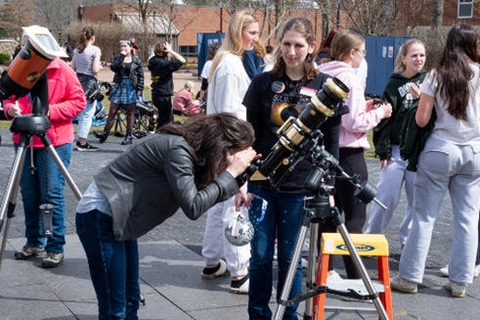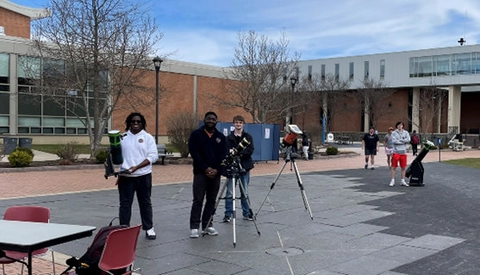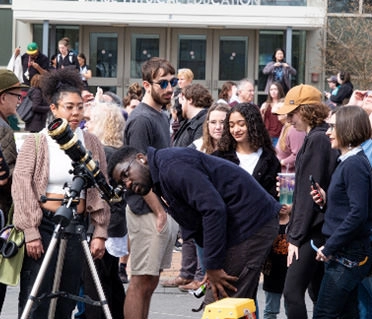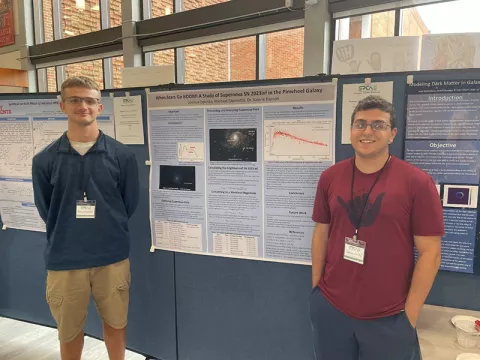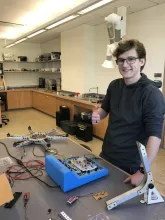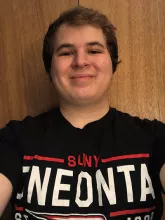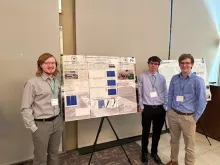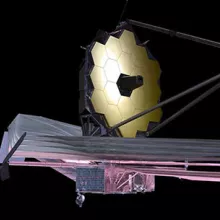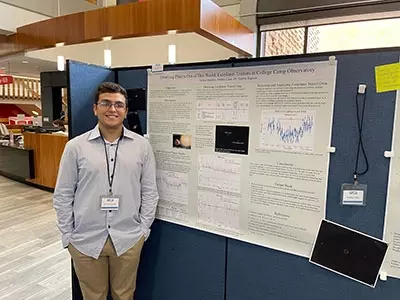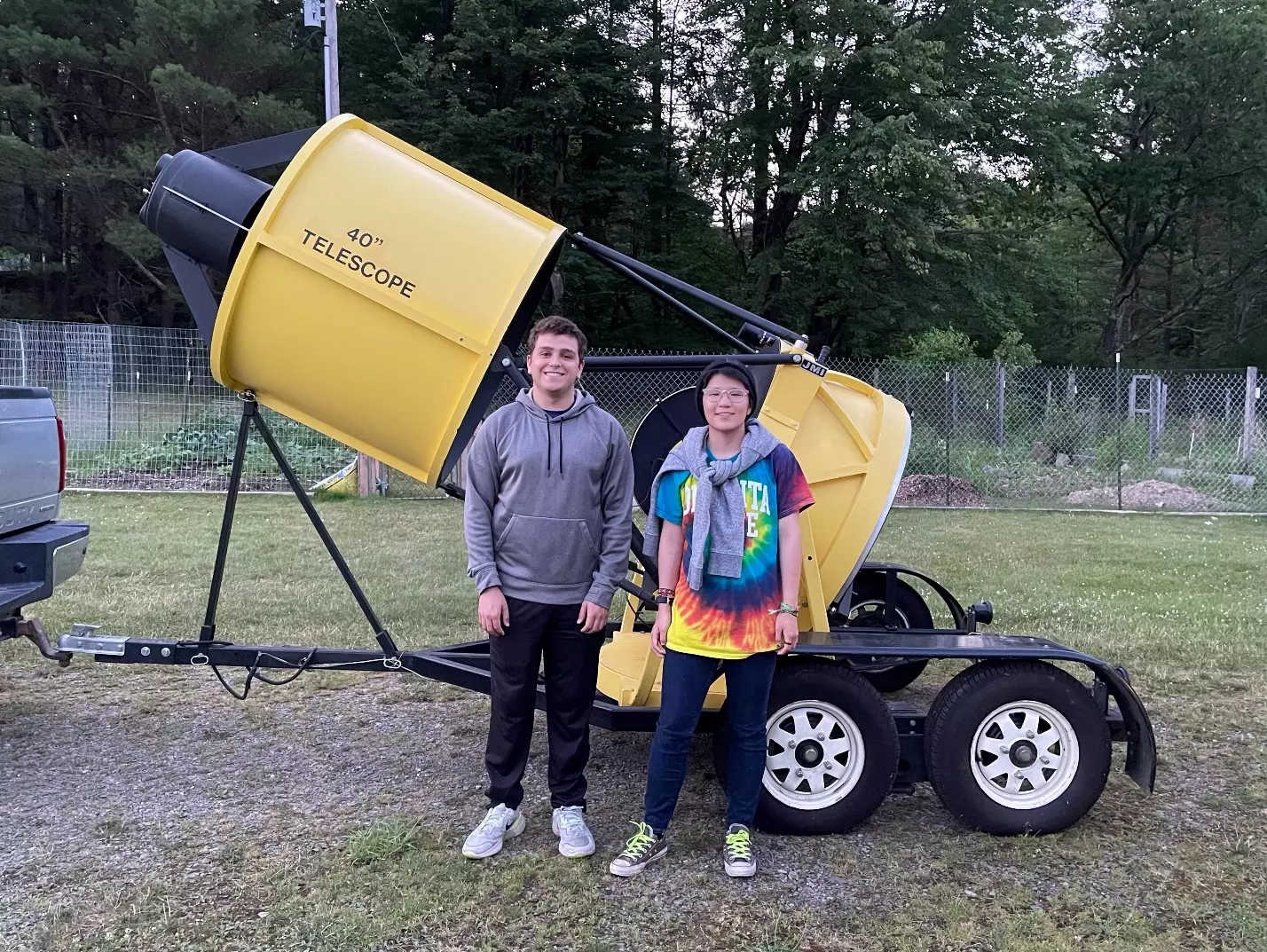Career Seminar Series
We have a vibrant and informative seminar series where Physics and Astronomy alumni and guest speakers have reflected on how their academic and professional preparation has helped them in some of their most interesting projects of their career.
Learn more about future seminars, or watch recordings of past seminars.
Recent News
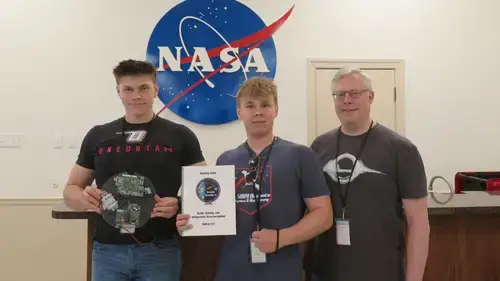
Students Ethan Biles and Jack Millen took their education beyond the classroom by joining Associate Professor of Physics and Astronomy Joshua Nollenberg at NASA’s Wallops Flight Facility. Located on Virginia’s eastern shore, Wallops is home to NASA’s annual RockOn! workshop, an immersive program where college students and faculty collaborate to build scientific instruments, attach them to a rocket and launch the rocket into space.
Biles and Millen prepared for RockOn! weeks in advance as part of their Physics summer internship course. While NASA provided everything at the workshop from detailed instructions to hands-on assembly, Nollenberg used the lead-up time to introduce the students to numerical methods for solving physics-based problems. After completing several simulations, the team turned its focus to understanding the rocket’s flight trajectory using equations of motion.
For the full story and more images from the day, go to Physics Students Launch Rocket at NASA Facility
Dr. Rapson first challenged SUNY Oneonta students with an eclipse glasses design competition. Victoria Hallenbeck, BFA ’24, won the competition with her eye-catching, vision-saving design.
During the week prior to April 8th, Physics & Astronomy students, their professors, and the Science Discovery Center brought a full slate of educational and entertaining activities to the campus and community, including Dr. Rapson’s interview with Hudson Mohawk Magazine, found at Eclipse and disco ball - Sanctuary For Independent Media (mediasanctuary.org). Ms. Rutenbeck and staff at the Science Discovery Center hosted special planetarium shows, a comedy show and a day full of unique eclipse-related events. Under the watchful eyes of Astronomy students Sam Sylvia, Ryheime Grant, Mike Gianetto, Jarett Deneau, and Skyler Reed, the Department’s telescopes were fully deployed.
This sampling of photos can vouch for the unique experiences that Dr. Rapson’s efforts and those of the Astronomy students brought to the entire campus.
For the full story and more images from the day, go to Solar Eclipse Captivates Campus, Guests | SUNY Oneonta.
The meeting gathered over 70 faculty and students from academic institutions across New York to discuss everything from star and planet formation to galaxy collisions to the latest James Webb Space Telescope discoveries. Physics student Jarrett Deneau presented his summer research on modeling gravitational lensing, Michael Giannetto shared his work on tracking the brightness of Supernova 2023ixf, and Josh Ippolito presented a poster on detecting exoplanet transits. Dr. Valerie Rapson also gave a short talk on the recent upgrades to the SUNY Oneonta 1m telescope and encouraged other universities to join a data gathering partnership to help get more students involved in research projects. After the meeting, participants had the opportunity to observe Jupiter, Saturn, and the Moon through Siena’s 0.7-meter telescope.
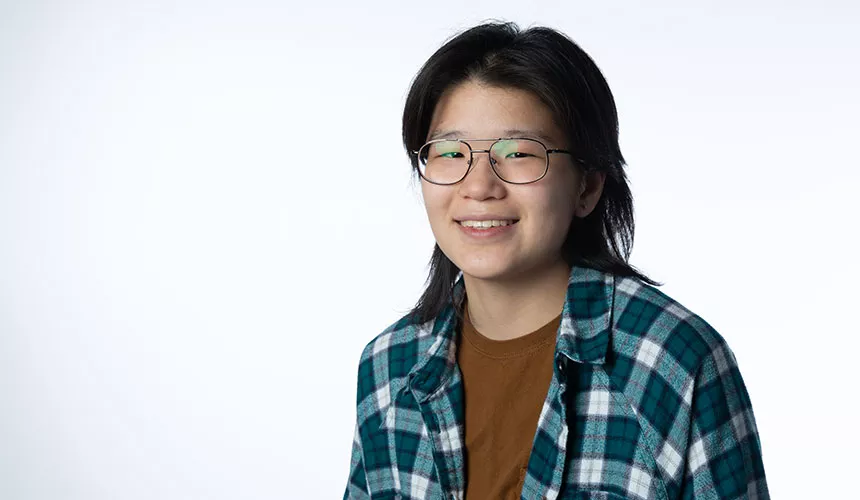
Congratulations to Hadley Chan whose student profile was featured in a recent edition of The Oneonta Bulletin. Read about her experiences while attending SUNY Oneonta.
Congratulations to Jacob Ghiorse who has accepted a summer internship at Ioxus, a premiere ultra capacitor and module manufacturer located in Oneonta, NY.
Multiple congratulations to Nathaniel Schwed. Nathaniel was selected for the Physics & Astronomy Department's Academic Achievement Award, maintaining a minimum GPA of 3.5 in the major and possessing notable extramural accomplishments. Nathan has also been accepted to Binghamton University (Mechanical Engineering) and the University of Buffalo as part of the 3-2 Engineering Program. Finally, Nathaniel has accepted a summer internship at Amphenol Aerospace. Amphenol Aerospace designs and manufactures custom electrical connectors for military and aerospace applications.
Popularity of the university's digital theater continues to grow with not only students and clubs on campus, but also with the community thanks to advanced technology and astronomy professors Dr. Nollenberg and Dr. Rapson. To read the full article, click on the link below.
Jacob Ghiorse, Andrew Lutz and Ryan Sliwinski win prize for Most Outstanding Poster at the New York State Section of the American Physical Society Fall 2022 Topical Symposium held at SUNY Brockport. The poster was the culmination of research conducted during Summer and Fall 2022. Congratulations go to Jacob, Andrew and Ryan. A description of the summer research can be found lower on this page.
As an official "Webb First Look Event" site, SUNY Oneonta will be hosting a fun evening of space exploration for students, staff and the general public on Friday, Sept. 30th from 6-8:30 pm. Visitors can explore interactive activities at the Science Discovery Center, view life-size print-outs of the latest JWST images, and watch the original press release of the first images.
Starting at 7 pm in Perna Science room 121, the main event will be a talk by SUNY Oneonta alumni Mike Engesser from the Space Telescope Science Institute who worked on the MIRI instrument on the James Webb space telescope.
To find out about other Webb First Look events, check out: Webbtelescope.org
When you think of astronomical discoveries you probably think of big telescopes high atop mountains taking data, or the beautiful images taken by the James Webb Space telescope. But even small backyard telescopes are capable of taking important data that teaches us more about our Universe, including searching for new planets around stars in the night sky. That’s exactly what SUNY Oneonta undergraduate students did this summer.
Exoplanets are planets that orbit stars outside of our solar system. Over 5000 planets have been discovered by ground and space-based telescopes, and there are thousands more candidate exoplanet systems waiting to be confirmed. Astronomers can use many different methods to find or study an exoplanet, but the most common one is the transit method. In this scenario, an exoplanetary system is tipped edge on relative to Earth. From our perspective, the planet appears to cross in front of the star, making the star appear to dim for a short time once per orbit. We don’t actually see the planet move in front of the star, but we can detect the periodic dimming of the star and infer that an exoplanet is present.
Students Hadley Chan and Joshua Ippolito, working with Dr. Valerie Rapson, spent the summer observing exoplanet transits with the 14inch telescope at SUNY Oneonta’s College Camp Observatory. Their main goal was to test the equipment’s capabilities to see if they could detect known exoplanet transits, and also attempt to observe some exoplanet candidates identified by the Transiting Exoplanet Survey Satellite (TESS). The students successfully observed full or partial transits from three exoplanetary systems: KELT-23 Ab, HAT-P-32b, and WASP-10b. These three planets are all Jupiter-sized planets that orbit very close to their host star, and only take a few days to make one full revolution around the star. A light curve of KELT-23 Ab is below, which shows the relative brightness of the star KELT-23 A over time. You can see that the star drops about 2% in brightness for a period of roughly 2.5 hours while the planet moves in front of the star. The data was fit with exoplanet light curve modeling code called EXOTIC, which helps to measure the transit depth and central transit time. Overall, we were able to successfully detect and measure the properties of a Jupiter-sized planet orbiting a relatively bright sun-like star!
Along with these three confirmed exoplanets, the students are actively taking and analyzing data for a few TESS exoplanet candidates. These stars are often faint at visible wavelengths, and push the limits of our detection capabilities with the 14in telescope. But if we are able to detect these exoplanet transits, we can determine the planet properties and learn more about the formation and evolution of planetary systems. SUNY Oneonta also has a 1m JMI folded-Newtonian telescope (the largest telescope in NY state!) and we hope to start using that to observe exoplanet transits in the near future. That telescope has much greater light gathering power than the 14in telescope, so we will be able to observe fainter targets with ease.
Small telescope observations of exoplanet transits are incredibly important. They can help confirm candidate planets, detect new never before seen exoplanet transits, and monitor known exoplanet systems for any changes. This data is crucial in the era of the James Webb Space Telescope. Small telescope data can help professional astronomers know exactly when and where to look with space telescopes to learn more about an exoplanetary system.
The students will be submitting their data to the AAVSO’s exoplanet light curve database and to a project called Exoplanet Watch which aims to keep close track of exoplanet transit times for use by space telescopes. In the future, we hope to study more exoplanet candidates and help confirm or deny their existence. If you have a small telescope and CCD camera and are interested in taking your own exoplanet observations, check out the Exoplanet Watch website for more information.
Contact the Physics & Astronomy Department
Physical Science II
108 Ravine Parkway
Oneonta, NY 13820
United States

